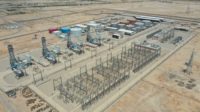A unit of Macquarie Infrastructure Corp. has filed plans with the local government in Chesapeake, Va., to build a 1,400-MW power plant.
The proposal is the latest of many power-plant projects in the works in Virginia and other locations in the region.
Developers are stepping up to replace aging plants, many fired by coal, with efficient, less-polluting gas-fired plants. But in a market where many plants are built on spec, each new project threatens the economics of all plants.
Virginia is within the footprint of the PJM Interconnection, the regional transmission organization that runs the competitive wholesale market for much of the mid-Atlantic region.
PJM lists 5,100 MW of generation capacity to be replaced from plants slated to retire by 2020. Every spring, PJM conducts an annual capacity market for power supplies three years into the future. The auction is designed to encourage developers to build power plants and ensure that there is adequate generation capacity in reserve to meet demand spikes.
This year, the market attracted 5,374 MW of new generation, but the clearing price, at $100 per MW per day, was lower than in the past two years. PJM says the auction results will ensure robust power supplies, with reserve margins nearly 6% above its 16.5% target.
That may be good news for customers, but it is a concern for generators, which depend on capacity prices for a good part of their revenues, and for power-plants developers, which look to capacity prices to help finance their projects.
As an alternative, developers often seek power purchase agreements, but in a region dominated by PJM’s competitive market, PPAs are hard to come by. In some cases, they have run into legal challenges.
In Virginia, especially in northern Virginia, power-plant development is driven by population growth and a proliferation of data centers by companies such as Amazon. The state also has a hybrid regulatory regime that encourages traditional utilities to develop power plants while posing challenges for merchant plants, such as Macquarie’s.
In 2007, Virginia passed legislation reestablishing retail rate regulation for most electricity customers in the state, which means Virginia has both traditional regulated utilities and participates in the competitive wholesale power market run by PJM.
So, if a utility such as Dominion Virginia Power builds a power plant, it applies to Virginia’s State Corporation Commission to approve the cost of the plant and include it in customers’ electric bills. If a developer such as Macquarie proposes a power plant, the company needs SCC approval and the company has to find an off-taker for its electrical output.
That means merchant power projects in Virginia face competition not only from other merchant developers, as would any power project developer in PJM, but also from the local utility, Dominion Virginia Power. And Dominion has been very busy in Virginia.
In June, Dominion brought on line a 1,358-MW gas plant in Lawrenceville, Brunswick County. That same month, the utility started construction nearby on a $1.3-billion, 1,588-MW gas-fired plant in Greensville County; that plant is due on line in late 2018. And earlier, in 2014, Dominion brought on line a 1,329-MW gas plant in Warren County.
To be fair, under SCC rules, Dominion has to put any power project it wants to build out to bid. But the regulated rate guaranteed under state law greatly simplifies financing and lowers the cost of capital.
Merchant projects face a higher hurdle. If they sell into the wholesale market, there is less certainty about off-take, and securing financing is much more difficult. Most merchant generators enter into hedging agreements, usually about five years in term, with financial institutions that serve as a short-term PPA that can be used to facilitate financing. Alternatively, a developer can sign a PPA, but it can be difficult to find an off-taker willing to sign a long-term PPA at rates above the cost of power in the competitive market. That was the downfall of one project in Virginia.
Competitive Power Ventures spent eight years developing a 700-MW gas plant in Atkins, Smyth County, only to pull the plug on the project in July. CPV had hoped to sign a PPA with Appalachian Power, but the utility determined it would not need new capacity for at least eight years. Without a PPA, CPV said there was not a clear path to finance the project.
In neighboring Maryland, CPV has a 725-MW project under construction in St. Charles County. With SNC Lavalin Constructors as the contractor, that project is being built on a merchant basis, selling into one of the more constrained PJM regions in which power prices tend to be higher. But that was not CPV’s first choice.
CPV originally had intended to sell the power to Maryland utilities under a state law that was amended to provide in-state generation a contract for differences based on PJM prices. But the Supreme Court in April ruled that arrangement violated the supremacy clause of the U.S. Constitution and could distort prices in PJM’s capacity auction, which falls under federal jurisdiction.
CPV’s original arrangement in Maryland reflected the desire of officials in some states to have more control over their in-state generation. It also satisfied the desire of merchant generators to have a long-term off-take agreement that could facilitate project financing.
New Jersey was the first PJM state to seek an exemption for in-state generation, but that law was struck down by a district court. Virginia’s 2007 law re-establishing retail rate regulation addressed those same concerns but, by and large, has avoided legal challenges.
Most observers say it is unlikely that a merchant developer would be able to sign a PPA with Dominion. State law also bars the developer from signing a PPA with an industrial customer, but a merchant generator could sign an off-take agreement with a municipal utility.
If a developer cannot land a PPA, it is back in the merchant market, which is the way that several projects have been developed in PJM. Panda Power Funds, for instance, has successfully completed several projects in the region by relying only on merchant power sales. The Dallas-based company has projects underway in both Virginia and Maryland. Panda’s 778-MW Stonewall gas plant in Leesburg, Va., is under construction—Bechtel is the contractor—and is due on line early next year. Panda’s 900-MW Mattawoman gas project in Brandywine, Md., is in “advanced development,” with a target on-line date of 2019.
Panda’s business model does not call for PPAs. “The era of long-term PPAs is really past,” Panda spokesman Bill Pentak said. Instead, Panda typically hedges the risk with a financial institution. Because of its corporate structure, Panda does not have the same challenge as developers that use a project finance model in which the project has to support itself without reliance on its corporate parent.
Panda is structured as a fund, Pendak points out. It is similar to a private equity player, so instead of going to banks to finance a project, the company raises funding from investors. Panda also claims to have one other competitive advantage: access to low-cost natural gas from the Marcellus shale field. Panda has said nearby access to pipelines carrying low-cost Marcellus gas will lower its transmission costs and make its plants more competitive.
Macquarie also will have access to natural gas flowing from West Virginia and Pennsylvania shale fields. Macquarie is developing the Chesapeake project through its Matex Virginia Power LLC affiliate on land owned by another affiliate, International-Matex Tank Terminals, which owns and operates storage and processing facilities for commodities such as oil and fertilizer.
Matex intends to build the power plant on land adjacent to its tank facility, which has access to transmission lines and gas pipelines, including a planned spur from the proposed Atlantic Coast Pipeline, which would run 550 miles from West Virginia through Virginia and into North Carolina. The pipeline is being developed by a consortium led by Dominion.
According to press reports, Matex has not subscribed to take gas from that line, but power-plant owners often are reluctant to lock in gas supplies in advance because they do not want to buy long-term gas supplies ahead of short-term electricity sales.
But on the off-take side, it would seem that Macquarie’s corporate preference would be to sign a PPA for the Chesapeake project.
The company’s current power portfolio consists of six solar and two wind power projects, totaling 266 MW, and a 512-MW gas plant in Bayonne, N.J., that the company intends to expand by 130 MW. Most of the output of those plants is sold under contract. On its website, the company says it has “developed a pipeline of contracted power investment opportunities” and is looking to “deploy additional capital in this segment over time.”
It would be “more accurate to say that our current portfolio has been largely contracted so far,” Macquarie spokeswoman Melissa McNamara says. In terms of financing and PPAs, those decisions are “still under way at this point,” she says, adding that the Chesapeake project is still in “the early stages of development.”
Macquarie has yet to apply for project permits from Virginia’s SCC or the Dept. of Environmental Quality. However, it is helpful to remember that one of the key drivers of new power projects in PJM is access to low-cost natural gas. And Macquarie’s not the only project on the path of the Atlantic Coast Pipeline: The proposed route passes through Greensville County, Va., where Dominion is building a power plant.
Meanwhile, competitors continue to crop up. Southern Power, the unregulated generation arm of southeastern utility giant Southern Co., last month signed an option to buy 300 acres in the Berry Hill Industrial Park from the Danville-Pittsylvania County Industrial Facility Authority for a potential gas-fired power plant.
Southern Co. also has an interest in the Atlantic Coast Pipeline, but the Berry Hill park is far from that route. Southern says it chose the Berry Hill site because it is adjacent to the Williams Transco natural-gas pipeline, which brings up gas from the Gulf Coast.
Southern has not said whether it has signed a gas-supply agreement with Transco but did say it intends “to have the output [of the proposed plant] covered by long-term, bilateral contracts with creditworthy counterparties.”
After access to natural gas, that link in the energy supply chain would seem to be the Holy Grail of power project developers in PJM.




Post a comment to this article
Report Abusive Comment